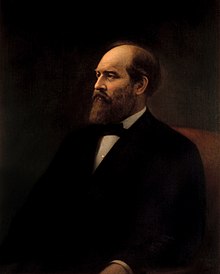Born in a Cabin in Cuyahoga County: The Tragic Curtailed Presidency of James A. Garfield
That James Abram Garfield is one of America’s least remembered Presidents(1) is something to lament in the light of the fact that the 20th man to hold office as such was manifestly a man of genuine decency, a true Christian gentleman. Yet, as the great American novelist Thomas Wolfe wrote of him in his short story The Four Lost Men:
‘For who was Garfield, martyred man, and who had seen him in the streets of life?’(2)
This ‘martyred man’ was born in a log cabin in Cuyahoga County, Ohio(3) on the 19th of November 1831 into a family affiliated to the Disciples of Christ denomination, also known as the Christian Church(4). Largely of English ethnicity, he was a descendant of Mayflower passenger and convicted murderer John Billington(5), while French Huguenot ancestry arose through his mother Eliza Ballou. His father, Abram Garfield, died when he was less than two years old and he was subsequently raised by his mother(6), notwithstanding a brief second marriage.
Aged 16, he worked for six weeks as a canal driver near the big city of Cleveland, before malaria forced him home.(7)
In March 1849, he joined the Geauga Academy in Chester, Ohio, founded by Free Will Baptists in 1842, where he discovered a taste for academia, which led to his being offered a teaching post in 1849, which he accepted, although his teaching career was not without its problems.(8)
A year later, aged 18, he was baptised and would remain a member of the Disciples of Christ denomination for the remainder of his life, as he wrote in his diary:
‘”Today, I was buried with Christ in baptism, and arose to walk in newness of life’”.(9)
From 1851 to 1854, he was a student at the Western Reserve Eclectic Institute, now known as Hiram College, founded by the Disciples of Christ in Hiram, Ohio, where he developed a special interest in Greek and Latin, and ended up teaching there, while serving as a preacher in local churches, then at Williams College, Williamstown, Massachusetts, from which he graduated in 1856. However, he decided against preaching as a vocation(10), returning instead to the Eclectic Institute, where he taught Classical languages, and where, while still only in his mid-twenties, he was elected principal in 1857 (a position he held until 1860 or 1861 according to the account).(11)
A year later, on the 11th of November 1858, he married one of his more gifted Greek pupils, Lucretia Rudolph, who, of German, Welsh, English and Irish ethnicity, was a Mayflower descendent such as himself, whose ancestors James and Mary Chilton had been among the original pilgrims(12). She went on to bear him seven children.
In 1859, he entered politics for the first time, becoming elected an Ohio state senator in 1859, serving as such for two years, while in 1860, he began to study Law, being admitted to the Ohio bar in that year(13).
When the Civil War began on April the 3rd 1861, he joined the Union Army, and the following August (the 18th), while still under 30 years old, he was promoted to lieutenant colonel of the 42cnd Ohio Volunteer Infantry, rising to the rank of brigadier general of the Twentieth Brigade in the Army of Ohio on the 10th of January 1862. Also in 1862, he was elected by the Republicans to the United States House of Representatives; and by the time he resigned his commission in December 1863 to take his seat in congress, he had been promoted to major general of volunteers(14). He was elected the 20th president of the United States in March 1881, an office he held for four months.
On the 2cnd of July 1881, President Garfield was shot by a one-time author influenced by the religious writings of John Humphrey Noyes, founder of the Oneida Community of New York with which he had been unhappily associated as a young man(15), and very briefly, lawyer, by the name of Charles Julius Guiteau. Like Garfield, Guiteau was a Midwesterner, born in Freeport, Illinois on the 8th of September 1881, of partial French ancestry, who had latterly written a pamphlet in support of the soon to be president, before becoming a desperate - and consistently rejected - seeker of political office.(16)
Garfield survived the attempt on his life, and was bedridden for several weeks in the White House, before being moved to the Atlantic Coast of New Jersey in September in the hope that the fresh air might provoke a recovery, but this was not to be and he died on the 19th of that month from a massive heart attack exacerbated by a variety of factors including severe infection of the wound, which served to fatally compromise his immune system.(17)
Before being so violently cut down, Garfield had led a brilliant and heroic life, having transcended the utmost indigence to ascend to the highest political office in America, becoming the only serving church minister to do so(18), and it was his faith that had inspired his affiliation with the Union cause, as Fred Rosen has written of him in this respect:
‘For him, fighting for the Union was a spiritual calling. It was quite simple; slavery was against the laws of God and Man and should be abolished.’(19)
Had he lived, it is possible that he would be spoken of in the 21st Century in the same breath as Washington, Lincoln, Roosevelt, Eisenhower, Kennedy, as one of the greatest and most fabled of all American Presidents, rather than being spoken of - if he is spoken of at all - as a mere ‘martyred man’ of American history. Yet, despite his obscurity, he could be said to be the very quintessence of all that is noblest in the American dream.
_______________________________________________________________________________
(1) Ira Rutkow, James A. Garfield: The American Presidents Series: The 20th President, 1881 (New York: Henry Holt, 2006), p. 3.
(2) Thomas Wolfe, The Four Lost Men: The Previously Unpublished Long Version, edit. by Arlyn and Matthew J. Brucolli (Columbia: University of South Carolina Press, 2008), p. 78.
(3) Ruth Tenzer Feldman, James Garfield (Twenty-First Century Books, 2005), p. 10.
(4) The Encyclopedia of the Stone-Campbell Movement, edit. by Douglas A. Foster (Wm. B Eerdmans Publishing, 2004), p. 95.
(5) Michael Newton, Crime and Criminals (Infobase Publishing, 2010), p. 24.
(6) Feldman, p. 11.
(7) Feldman, p. 17.
(8) Allan Peskin, Garfield, a Biography (Kent, Ohio: The Kent State University Press, 1978), p. 16.
(9) Feldman, p. 28
(10) William C. Ringeberg, The Religious Thought and Practice of James A. Garfield: The Stone-Campbell Movement: An International Religious Tradition, edit. by Michael W. Casey and Douglas Allen Foster (Knoxville: University of Tennessee press, 2002), p. 219.
(11) Michale Duvalle, Complete Book of Historic Presidential Firsts: With Fascinating Details & Factual Tidbits (Bloomington, Indiana; XLibris Corporation, 2009), p. 125.
(12) Chronology of the U.S. Presidency: Volume One: George Washington through James Knox Polk, edit. by Matthew Manweller (Santa Barbara, California: ABC-CLIO, 2012), p. 629.
(13) Duvalle, p. 125.
(14) American Civil War: The Definitive Encyclopedia and Document Collection, edit. by Spencer C. Tucker (Santa Barbara, California: ABC-CLIO, 2013) p. 744.
(15) Charles E. Rosenberg, The Trial of the Assassin Guiteau: Psychiatry and the Law in the Gilded Age (Chicago: University of Chicago Press, 1968), p. 19.
(16) Jonathan Goodman, Bloody Versicles: The Rhymes of Crime (Kent, Ohio: Kent State University Press, 1993), p. 36.
(17) David J. Phillips, On This Day (Bloomington, Indiana: iUniverse, 2007), p. 159.
(18) Duvalle, p. 125
(19) Fred Rosen, Murdering the President: Alexander Graham Bell and the Race to Save James Garfield (Lincoln: University of Nebraska Press, 2016), p. 34.

